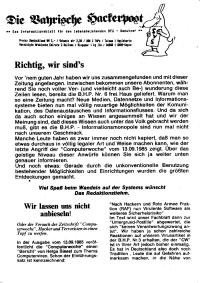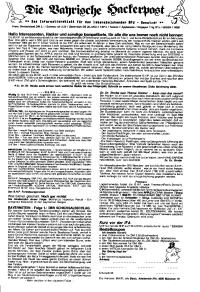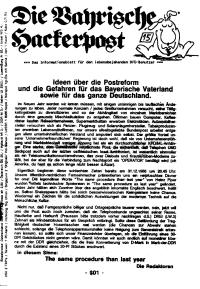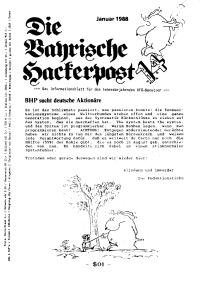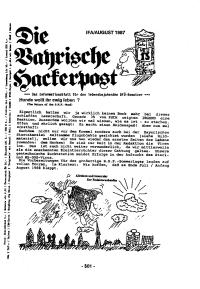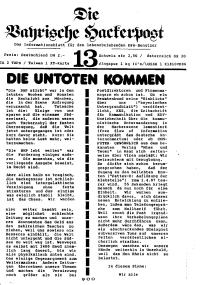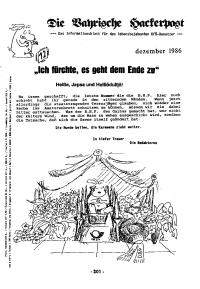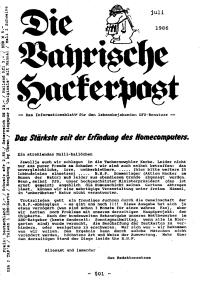Copy Link
Add to Bookmark
Report
HOMEBREW Digest #2849

HOMEBREW Digest #2849 Wed 14 October 1998
FORUM ON BEER, HOMEBREWING, AND RELATED ISSUES
Digest Janitor: janitor@hbd.org
Many thanks to the Observer & Eccentric Newspapers of
Livonia, Michigan for sponsoring the Homebrew Digest.
URL: http://www.oeonline.com
Contents:
Spray on Sanitizer (Badger Roullett)
BIG Carboys ("silent bob")
240 volt gfci's (AlannnnT)
RE: source for CO2 cylinders (Robert Arguello)
lactic vs. phosphoric acid (Al Korzonas)
1998 HBD Name-Dropping Award (Al Korzonas)
Re: Polder Thermoprobes (Robert Arguello)
ireks ("Bayard W. Wenzel")
Re: Pewter... (Tim Anderson)
Liquor to Grist Ratio (Troy Hager)
drilled stoppers (Scott Murman)
Al K's Book, pewter ("Rick Wood")
Re: Censorhip/Pumpkin Beer (Scott Murman)
No hot break (Jim English)
240V GFCI, grounding (fridge)
spam!! ("Dave Olson")
Re: Brewer's Gold hops (Gary H Nazelrod)
Re: Brewer's Gold hops (Jeff Renner)
Clarification (Steve Jackson)
R.I.P -- Westchester Brewing Co; White Plains, NY (John Biggins)
Fruit Flies, stop the stoppers (Paul Niebergall)
Wyeast 2565 - Excessively Slow? (Charley Burns)
Queen of Beer - Competition Results (Charley Burns)
Hops aroma and flavour problems (Eric Reimer)
240V (Jeremy Bergsman)
co2 ("Spies, James")
RE: Subject: 240V GFI ("Bonnell, Doug")
Re: 240V GFI ("RANDY ERICKSON")
Outatown, ("David R. Burley")
Re: Fruit Flies ("John A. MacLaughlin")
Olde Brew from Rampant Badger (Badger Roullett)
RE: Source for keg parts (John Wilkinson)
first wort hopping (Al Korzonas)
Beer is our obsession and we're late for therapy!
Send your entries in for 3rd Annual Music City Brew-Off yet?
Details: http://www.theporch.com/~homebrew
NOTE NEW HOMEBREW ADDRESS: hbd.org
Send articles for __publication_only__ to post@hbd.org
(Articles are published in the order they are received.)
If your e-mail account is being deleted, please unsubscribe first!!
To SUBSCRIBE or UNSUBSCRIBE send an e-mail message with the word
"subscribe" or "unsubscribe" to request@hbd.org.
**SUBSCRIBE AND UNSUBSCRIBE REQUESTS MUST BE SENT FROM THE E-MAIL
**ACCOUNT YOU WISH TO HAVE SUBSCRIBED OR UNSUBSCRIBED!!!
IF YOU HAVE SPAM-PROOFED your e-mail address, the autoresponder and
the SUBSCRIBE/UNSUBSCRIBE commands will fail!
For "Cat's Meow" information, send mail to brewery@hbd.org
Homebrew Digest Information on the Web: http://hbd.org
Requests for back issues will be ignored. Back issues are available via:
Anonymous ftp from...
ftp://hbd.org/pub/hbd/digests
ftp://ftp.stanford.edu/pub/clubs/homebrew/beer
AFS users can find it under...
/afs/ir.stanford.edu/ftp/pub/clubs/homebrew/beer
JANITORS on duty: Pat Babcock and Karl Lutzen (janitor@hbd.org)
----------------------------------------------------------------------
Date: Mon, 12 Oct 1998 11:13:19 -0700
From: Badger Roullett <branderr@microsoft.com>
Subject: Spray on Sanitizer
Greetings, and Salutations...
I was wondering if you could help me with a thought. What do people use a
spray on, and use right away sanitizer? and what ratios? I know some
people use this for quick sanitizing of funnels, taps onsite, etc. I have
heard of bleach solutions, idofor solutions, etc. what ratios though? to
be used in spray bottle.
TIA, Badger
***************************************************
Brander Roullett aka Badger
Homepage: http://www.nwlink.com/~badger
In the SCA: Lord Frederic Badger of Amberhaven
"It had to be a linguistics professor who said that it's man's ability to
use language that makes him the dominant species on the planet. That may
be. But I think there's one other thing that separates us from animals. We
aren't afraid of vacuum cleaners." --Jeff Stilson
------------------------------
Date: Mon, 12 Oct 1998 11:13:47 PDT
From: "silent bob" <holdenmcneil@hotmail.com>
Subject: BIG Carboys
Hey all,
I saw the post mentioning BIG carboys (in my mind anythig greater than 7
gallons). If someone has a source of these I would be interested. Any
thing to minimize the number of dishes to do!
TIA
Adam
______________________________________________________
Get Your Private, Free Email at http://www.hotmail.com
------------------------------
Date: Mon, 12 Oct 1998 14:23:12 EDT
From: AlannnnT@aol.com
Subject: 240 volt gfci's
Doug wrote>> What concerns me is the lack of a ground leg on your
standard 240V outlet here in the US. I know that for all intents the neutral
leg is the same
as ground, but is that good enough and are there GFI breakers available for
240V?
Doug,
The brand new codes for 240V dryer hookups in the US call for 4 wires,
including a 'neutral' and a ground and the two 'hot' legs.
So you could wire your heater with a new style 4 wire dryer outlet and plug.
They are not expensive. This gives you two 'hots', a common and a ground.
More importantly- the neutral wire you are talking about in the 3 wire 240
system is NOT a neutral. Only the 3 wire 120, or the 4 wire 240 has a neutral.
Be careful! Three wire 240 is not the same as three wire 120. Both insulated
wires in the 240 system carry current to the device, {if using romex} the bare
wire is, of course, the ground.
If using wire in conduit, you need to check which two wires are hot. The
difference is sort of semantic, but you don't someone out there thinking that
the "white" wire in the 240 box in their three wire dryer outlet is not always
hot, 'cause it is.
Best Brewing,
Alan T
------------------------------
Date: Mon, 12 Oct 1998 11:48:36 -0700 (PDT)
From: Robert Arguello <robertac@calweb.com>
Subject: RE: source for CO2 cylinders
Fri, 9 Oct 1998 12:22:12 -0700 (PDT)
Scott Murman wrote:
>I'm probably going to buy myself a keg setup for X-mas, and I was
>wondering if there was a good source for CO2 cylinders and gauges.
>I'm wondering about both $$ and safety issues (certification, etc.). I
>can't imagine that there isn't a commercial outfit that specializes in
>gas that could provide a new setup with all the safety checks for a
>reasonable price. Anyone been down this road?
Here's what I have going Scott....
I have an agreement with a local fire extinguisher service company. They
provided me with a 50LB co2 tank and a 20 LB tank. I paid a $25.00
REFUNDABLE deposit for the tanks. I use the 50 lb tank until it is empty,
then call the company for a full tank. It takes them a day or two to deliver
the new 50 pounder and in the meantime, I use the 20 pound tank. When they
deliver the full 50 pounder, I pay them only for the gas which comes to
$19.00. When the 20 pounder finally gets empty, they replace that with a
full one for $16.00. As you can see, the bigger the tank, the cheaper the gas!
One benefit of this, (besides the obvious), is that you don't have to worry
about certifications etc. The tanks belong to the fire extinguisher service
folks and that is their worry, not mine or yours.
Look in your local yellow pages under "Fire Extinguisher". I'll bet you can
get a similar deal going, although you might not be able to get them to
deliver the gas for free, I definitely lucked out there. You might have to
take the cylinders in for replacement yourself.
********************************************************************
Robert Arguello <robertac@calweb.com>
CORNY KEGS FOR SALE! $13.00 each
http://www.calweb.com/~robertac/keg.htm
ProMash Brewers' Software - http://www.calweb.com/~robertac/promash
********************************************************************
------------------------------
Date: Mon, 12 Oct 1998 14:10:36 -0500 (CDT)
From: Al Korzonas <korz@xnet.com>
Subject: lactic vs. phosphoric acid
Scott writes (quoting me):
>>Lactic acid is preferable to phosphoric (the other common acid used in
>>the mashtun), actually. Both will lower pH, but calcium lactate is
>formed
>>when you add the former and calcium phosphate when you add the latter.
>>Since calcium lactate is more soluble than calcium phosphate, you end
>>up with more calcium in your wort (in the boiler and fermenter) when you
>use
>>lactic acid. This calcium is important for reducing oxalate haze and
>>promoting yeast flocculation.
>
>Al,
>This is the first time I've heard this. In fact, I'm sure I've read to
>the contrary, although I can't recall where at the moment. If your mash
>already has significant (or let's say sufficient) calcium, is it still
>advantageous to use lactic acid? The reading I've done recommends
>phosphoric acid as some phosphor compound (don't recall which, but I think
>this is widely recognized) is beneficial as a yeast nutrient. My water is
>high in calcium carbonate, which is the exact reason I need to acidify.
>So, I'm already calcium-rich. What does lactic acid buy me? FWIW, I use
>phosphoric acid now.
I'm not a chemist, so I'll leave it to them to post on the actual reactions,
but I do know that the result of adding lactic or phosphoric acids, if
you have sufficient calcium in the mash/wort is that calcium lactate or
calcium phosphate are formed. The latter is virtually insoluble in wort/beer
and so it will flocculate out taking precious calcium out with it. I
believe that those who have said that the phosphoric acid results in some
yeast nutrient are probably not aware of the chemistry. As far as I know,
given enough calcium, I don't believe any phosphate would be available
for yeast nutrition.
If you have just enough calcium, then yes, lactic acid will keep more of
it in solution and less in precipitates than phosphoric. If you have an
abundance of calcium, then I believe that whichever acid is cheaper may
be better. However, there is the issue of two hydrogens versus three and
the issue of varying concentrations (the lactic acid I get is 88% whereas
the phosphoric is only 10%). Perhaps the chemists could comment on these
also?
Al.
Al Korzonas, Palos Hills, IL
korz@xnet.com
http://www.brewinfo.com/brewinfo/
------------------------------
Date: Mon, 12 Oct 1998 15:05:11 -0500 (CDT)
From: Al Korzonas <korz@xnet.com>
Subject: 1998 HBD Name-Dropping Award
...and the 1998 HBD Name-Dropping Award goes to (envelope please)...
John Adams for "GABF: Trip Report" in which John name-dropped:
11 breweries,
8 bars and brewpubs,
25 people, and
15 commercial beers
all in one post!
Congratulations, John!
;^)
Al.
------------------------------
Date: Mon, 12 Oct 1998 12:21:41 -0700 (PDT)
From: Robert Arguello <robertac@calweb.com>
Subject: Re: Polder Thermoprobes
Duff Hickman wrote in part:
>I also had one of these thermometer/timers start to give wacky readings
>after 1 or 2 uses. I think the problem is that they are designed for use
>in roasts, etc that are in the relatively dry environment of a heated oven.
>Assuming that you have the same model as mine, the upper end of the probe
>is just crimped onto the shielded wire and not sealed.
>To test this theory and attempt to remedy the situation, I stuck the probe
>into an oven and heated it to 300F to dry it out.
>It appears to work OK now, but I don't think I'd advise a friend to buy one.
Your theory is correct Duff. These probes are not sealed in any way beyond
the crimp. The woven stainless steel mesh covering the lead is actually one
of the conducters for the thermistor. Liquid getting past the crimp enters
the body of the probe and creates havoc. The fix is to allow to dry for a
number of days or you can force dry in a medium oven. PREVENTION: Starting 1
inch beyond the crimp and extending 12 inches along the wire, liberally coat
the stainless mesh with silicon sealant, (the clear aquarium grade). Make
the coating as smooth as possible. Allow to cure for a day or so then cover
the silicon with shrink tubing. After this is accomplished the probe can be
completely immersed without trouble.
Robert A.
********************************************************************
Robert Arguello <robertac@calweb.com>
CORNY KEGS FOR SALE! $13.00 each
http://www.calweb.com/~robertac/keg.htm
ProMash Brewers' Software - http://www.calweb.com/~robertac/promash
********************************************************************
------------------------------
Date: Mon, 12 Oct 1998 15:31:48 -0400 (EDT)
From: "Bayard W. Wenzel" <biomorph@moloch.mse.tay.dec.com>
Subject: ireks
Al K. sez:
>Rob writes:
>
>>Does anybody know where to find specifics, ie. malt analysis, on the Ireks
>>line of malts. Although Vinotheque tells me that Ireks is a large
>>maltster/grower, a brewing buddy and I find it strange that there is no
>>info easily obtainable, such as on the WWW.
>
>Weyermann makes much (all?) of Ireks malt and as far as I know, the former
>importer of Ireks (Crosby and Baker) has switched over to buying directly
>from Weyermann, so I'm not sure if you can even get Ireks malt anymore
>(you can still get their malt extract, I believe).
i just called up vinotheque (you can get the phone number via
www.vinotheque.net, why they're a .net is beyond me), and inquired
a bit into the ireks situation. according to the nice fellow there:
a.) ireks makes their own malt, and sells to weyerman
b.) weyerman's is more highly modified than ireks; he recommended
decoction mashing ireks for best results
c.) he imports ireks directly, in 20 ton lots
he even offered me lot specs! what a sweetheart.
i suspect the proximity of vinotheque to crosby and baker may
be significant- by offering variety, vinotheque can likely
maintain market share against its (likely larger) competitor.
best,
bayard
------------------------------
Date: Mon, 12 Oct 1998 12:29:12 -0700 (PDT)
From: Tim Anderson <timator@yahoo.com>
Subject: Re: Pewter...
I recently received a shiny new pewter beer mug as a gift from
coworkers in the U.K. (And a wonderful gift it was. I never thought
I'd drink beer out of something opaque, but this gets daily use). I
no longer have the box it came in, but I do remember that it was made
in Sheffield and it clearly stated that it was lead-free.
tim
==
Please ignore the advertisement below. Thank you.
_________________________________________________________
DO YOU YAHOO!?
Get your free @yahoo.com address at http://mail.yahoo.com
------------------------------
Date: Tue, 13 Oct 1998 02:28:57 -0700
From: Troy Hager <thager@bsd.k12.ca.us>
Subject: Liquor to Grist Ratio
Fellow brewers,
Was reading up on stout in the Lewis book and he suggests using "a
liquor-to-grist ratio of 2.5:1 to 3:1 ... for infusion mashing."
Can anyone clarify this for me?
I usually mash at about 1-1.5 qts. per lb. of grain. He doesn't state any
units. I have noticed that most homebrew books and publications use
qts:lbs.
I'm confused. Private email is good. Thanks!
-Troy
------------------------------
Date: Mon, 12 Oct 1998 22:35:46 -0700 (PDT)
From: Scott Murman <smurman@best.com>
Subject: drilled stoppers
I picked up a two-hole stopper for my ehrlenmeyer flask today at the
local lab supply shop for the princely sum of US $0.40. I can't
emphasize enough the usefulness of searching out a local lab supply
house, and building a raport with them. I go to mine quite
frequently, and they know me by name, and know I'm using the stuff for
brewing. Flasks, stoppers, stir plates, pH strips, barb connectors,
lab quality thermometers (for less than $5!!), test tubes,
microscopes, brewing salts, etc. You get the idea. They have a whole
storeload of stuff that we brewers use, it's cheaper than any other
source, there's usually one in every decent-sized city, and they'll
never turn away business.
Or ..., you could spend $3, 30 min., and 5 ml of blood trying to bore
through a stopper yourself.
-SM-
------------------------------
Date: Tue, 13 Oct 1998 16:17:33 +1100
From: "Rick Wood" <thewoods@netpci.com>
Subject: Al K's Book, pewter
Hello All,
I have been pestering Al K regarding the publication of his next book, Vol
2. He says not to expect it for a year or more. I for one am looking
forward to it, as I enjoyed the Vol 1.
Regarding the discussion of pewter:
Antique Pewter is an alloy of Tin (>90%) and Lead. Obviously, this is not
food grade. Modern Pewter may have Antimony, Copper, Cadmium as well as Tin
(and Lead). Again, Pewters with Cadmium are not food grade. The Lead is
used to give a dark color as well as to prevent pitting. Cadmium is used in
increase the "polishability" of the product.
Modern Food grade pewters contain Tin (~92%), Antimony (~8%) with maybe a
percent of Copper. Antimony free Pewters may contain Silver, Bismuth and
Copper as well as the predominant Tin.
Lastly, there are some Aluminum Alloys which have the appearance of Pewter
and are food grade. These may contain Silicon and Magnesium as well. The
Aluminum "Pewter" is considered food grade.
Regards,
Rick Wood
"Brewing on Guam"
------------------------------
Date: Mon, 12 Oct 1998 23:14:46 -0700 (PDT)
From: Scott Murman <smurman@best.com>
Subject: Re: Censorhip/Pumpkin Beer
>> P.S. I have a list of topics and posters that I feel are a not
>> sufficiently contributing to the S/N ratio. Who do I send it to for
>> consideration? "
>
> I'm sorry, and please take me off your list!
Anyone willing to tackle pumpkin beer will never be on any of my
lists! Not that I would ever keep one in the first place. BTW
Spencer T., it was a joke!
Jeff Tonole, HBD lurker (hi Jeff you're on the HBD) and I made a
pumpkin brew a few weeks back, and had a heck of a time (in both
senses). I think Jeff is going to post a synopsis that makes him look
good one of these days.
> Topics:
> Will more pumpkin give more "pumpkin flavor?"
Uhh, yes. Unless you use a cucumber, and then you'll get more
cucumber flavor.
> Will more residual sweetness enhance the pumpkin flavor?
I like to stick with plain pale ale malt and pumpkin. I like the
orange color, and use the pumpkin as sort of a crystal malt. If you
use crystal malt, you get more of a brown coloring. The problem
becomes lautering. As you increase the percentage of pumpkin to get
more flavor (we used 50%), you get a larger lauter headache. We tried
rice hulls, but the pumpkin just laughed at them.
> Am I the only one who makes beer INSIDE pumpkins?
Someone here used the pumpkin to lauter in. Stuck a slotted copper
manifold in the bottom of a XXX-large one, and mashed inside. Was
that you?
> Might I have extracted undesirables by including the pumpkin rind?
Undesirables in pumpkin beer?!
> Eric (Tryin' to sneak one by SM) Fouch
Fat chance.
-SM-
------------------------------
Date: Tue, 13 Oct 1998 07:17:58 -0400
From: Jim English <jimebob@mindspring.com>
Subject: No hot break
Brewed a Redhook ESB clone yesterday and got no hot break
that I could see. This has happened before but I haven't
kept thorough enough notes to be able to state categorically
what the effects might have been on the afflicted brews.
Shame on me, I found my thermometer was reading 3 degrees F
low after I was done brewing! Never again! I've seen the
light.
Could the temperature problem (vis a vis mashing temp.,
sparge water temp) cause this situation?
What can I look forward to as far as effects on my finished
beer?
I seem to lose too much heat out of my mashtun (cheap cooler
with copper manifold) and so have relied on pulling a sort
of decoction (liquid only), about 2 qts and heating it on
the stove to 168-170F and adding it back in to try to
raise/maintain the temp. during the mash. Sometimes I do
that several times rather than thin out the mash too much.
Comments?
Let's talk brewing, it's that time of year. Let's leave the
real technical treatises for the dog days of August.
TIA
JRE
Duluth, GA.
------------------------------
Date: Tue, 13 Oct 1998 08:54:47 -0400
From: fridge@kalamazoo.net
Subject: 240V GFCI, grounding
Greetings folks,
I had hoped to see a post from an electrician to help
clarify the the 240V GFCI questions, but since questions
continue, I'll see if I can shed some light on the subject.
I'm not a licensed electrician although I have done a lot of
electrical installation and troubleshooting related to
industrial equipment. I also do a large amount of
electrical/electronic control system design and
construction as part of my current employment.
It is true that the neutral conductor in both 120V and
240V circuits is connected to a terminal strip in the
distribution panel that is physically grounded to the panel
housing, as is the ground conductor. The panel is then
grounded to a rod driven into the earth. Many 240V
circuits have both neutral and ground conductors since
the powered equipment needs 120V for controls or for
other purposes. Many others don't use a neutral since the
equipment requires only the 240V. A ground conductor is
still required.
The neutral conductor is part of the electrical current path
and may be shared with other electrical devices. Any
electrical resistance or opening of the ciruit in the neutral
wiring path will place a voltage on the neutral conductor
with respect to earth ground. If a person were to touch the
neutral and earth ground, he/she becomes the ground
conductor and will receive a shock.
A separate ground conductor is connected between the
panel ground terminal strip and the conductive chassis or
housing of the connected equipment to carry off any stray
voltage that may accumulate.
Please ground *everything* in a brewing system. A
plastic hot liquor tank with an ungrounded heating element
creates a *very* dangerous situation. Any stray voltage
will be conducted away by the person who touches the
liquid contents of the vessel.
I have no first-hand experience with 240V GFCI's. Ken
Schwartz (Kenny Eddy), however, has done much with
electric kettles and such and has stated that 240V GFCI's
are available but are expensive. He has divided his
circuitry into two 120V circuits and installed two 120V
GFCI's. See his web site for further info and a wealth of
related information.
Try http://home.elp.rr.com/brewbeer/
Any electricians lurking out there that can shed more light
on the subject, please speak up.
Hope this helps!
Forrest Duddles - FridgeGuy in Kalamazoo
fridge@kalamazoo.net
------------------------------
Date: Tue, 13 Oct 1998 08:15:05 -0500
From: "Dave Olson" <Dolson@metrosales.com>
Subject: spam!!
>Has anyone else recently been getting hit with more spam than usual? I'm
>not on the web, and most of my mail is from HBD, MLD, and CLD, plus a few
>family and friends.
>Most of this unpalatable meat is from YAHOO origins. Any suggestions?
I too have been recieving spam! I usually get mail related to advertising
and marketing as that is my profession (my e-mail address has the word
"sales" in it). I usually get an unsolicited mailing with a Yahoo domain.
There is no way to unsubscribe. As far as I can see, by unsubscribing you
are affirming the spammer that you recieved their mail and probably read it.
I started recieving spam shortly after my first post.
- --dave--
------------------------------
Date: Tue, 13 Oct 1998 09:04:00 -0400
From: Gary_H_Nazelrod@tst.tracor.com (Gary H Nazelrod)
Subject: Re: Brewer's Gold hops
In HBD 2848 "Jay Krause" <krause@galis.com> asks:
>A simple question I hope. I am having trouble finding Brewer's Gold hops
>in any form. What would be a good substitute for this variety?
I do not know what would be a good substitute. But Just Hops has them
listed on the web at http://www.realbeer.com/hops/justhops.html. I do not
know if they currently have them in stock. No affiliation, just a
satisfied customer.
Gary Nazelrod
Silver Spring MD
------------------------------
Date: Tue, 13 Oct 1998 09:12:54 -0400
From: Jeff Renner <nerenner@umich.edu>
Subject: Re: Brewer's Gold hops
"Jay Krause" <krause@galis.com> asks:
>A simple question I hope. I am having trouble finding Brewer's Gold hops in
>any form. What would be a good substitute for this variety?
In _Using Hops: The Complete Guide to Hops for the Craft Brewer_, Mark
Garetz suggests substituting "Northern Brewer, Galena, or any other
bittering hop to your liking." He also says that its aroma is "not highly
regarded, but reasonably neutral in character." I think that flavor of
boiling hops can come through even after a long boil, so you might get some
differences. He says that Bullion shares the same wild Canadian ancestor
as Brewer's Gold, so it might be a good choice, although its "High oil
content means that aroma may come through stronger if boil times are short
or when used in a very light lager." He also says that Galena was bred
from open pollination of Brewer's Gold.
Jeff
-=-=-=-=-
Jeff Renner in Ann Arbor, Michigan c/o nerenner@umich.edu
"One never knows, do one?" Fats Waller, American Musician, 1904-1943.
------------------------------
Date: Tue, 13 Oct 1998 07:03:34 -0700 (PDT)
From: Steve Jackson <stevejackson@rocketmail.com>
Subject: Clarification
In HBD #2847 (Oct. 12, 1998), Bob Poirier wrote:
>>>>
PS - Regarding the concerns about censorship of the HBD, after reading
all the posts to date on this issue, though I understand where Steve
Jackson is coming from, I personally don't believe that the HBD is
going to become a Nazi/communistic-like entity <snip>
<<<<
Just for clarification, that wasn't me. Aside from this, I haven't
offered any comments regarding the now twin-headed "C-word" (Clinitest
and censorship) debate. I have my opinions, but I'm keeping them to
myself (my mother would be amazed).
-Steve in Indianapolis
_________________________________________________________
DO YOU YAHOO!?
Get your free @yahoo.com address at http://mail.yahoo.com
------------------------------
Date: Tue, 13 Oct 1998 10:20:53 -0500
From: jbbiggin@mail.med.cornell.edu (John Biggins)
Subject: R.I.P -- Westchester Brewing Co; White Plains, NY
Well, the inevitable happened. The 1st Brewpub in Westchester County north
of NYC, the Westchester Brewing CO (WBC) has gone belly up after months of
financial difficulties. Even though the beer rapidly became sub-par & did
not have many of the "staples" required for repeat business (a simple red,
pale, etc..), it is still sad to see such a business depart. The good news
is the far better Fireworks Brewery around the corner is still going, but
I'm shy to say if its going strong. Whenever I go there at nights on
weekends (I don't live in the area any more, so I can't vouch for
attendence) it's sparsely populated. Perhaps they get good lunch business
from the stock brokers in the surrounding area?
Oh well...another brewpub bites da dust. RIP!
BTW...I never did get my "free" mug after having my WBC preferred customer
card swiped WAY more than the minimum amount. Didn't treat your regulars
well...no wonder you went Chapter 11. But they had GREAT bourbon chicken
wings! Wish I can get the recipe.
-------------
John B. Biggins Cornell University Medical College
1233 York Ave; Apt 19D Memorial Sloan-Kettering Cancer Center
New York, NY 10021 Graduate School of Medical Sciences
(212)717-0158 Student -- Program in Pharmacology
"Science, like Nature, must also be tamed
With a view towards its preservation.
Given the same state of integrity
It will surely serve us well."
-- Neil Peart; Natural Science (III) -- Permanent Waves
------------------------------
Date: Tue, 13 Oct 1998 09:31:54 -0500
From: Paul Niebergall <pnieb@burnsmcd.com>
Subject: Fruit Flies, stop the stoppers
Allen W Senear makes some excellent points concerning
fruit flies in beer:
>Mike Maceyka replied:
>>"Inocclulated it with bacteria: absolutely. Contaminated it, i.e.
>>will this ruin my beer: yes, in all probability."
{snip}
>I believe that this experience once again reiterates one of the basic
>rules of brewing: Although there are many things, especially
>lapses in sanitation, that can ruin your beer, few of them will do so
>every time; until you have irrefutable experimental evidence (ie
>tasting) that your beer is definitely bad, don't despair or dump, it
>may well be fine, or at least good enough for the uninvited house
>guests who have printed up stationary with your address and phone
>number on it. I recently had one of my early batches finally
>transform itself after five months in the bottle from something I
>could drink but with little enthusiasm into a pretty good beer
>(unfortunately I drank over half the batch while it was still only in
>the tolerable stage.)
Allen has discovered a contradiction in thinking among HBD
readers. Allow me to elaborate further. Let's think about this fruit
fly thing from another angle. What if you took a fruit fly and
dipped it in isopropanol to sterilize it (o.k., it is dead now, but
forget about that for a moment). After sterilizing the fruit fly, rinse
it in distilled water and then dip it into a tiny amount of frothy
yeast starter that has been previously prepared. Now take the yeast
coated fruit fly and place it in a carboy along with five gallons of
your favorite boiled and cooled wort. How many people out there
in HBD land would exclaim that I was crazy and that there is no
way you can get any fermentation at all from less than a pin-head
sized drop of yeast? However, what you have just done is
inoculate your wort with probably a million times more yeast cells
than the number of bacteria cells present on an average fruit fly.
Why is it that we think that it takes nothing less than a couple of
billion yeast cells to make a good batch of beer, and yet a few
bacteria will absolutely ruin a batch of beer? Keep this sanity
check in mind next time you are contemplating a couple of
hundred dollars for a laminar flow hood, or a couple thousand
dollars for an autoclave.
Drilling stoppers: I think this is the next candidate for censorship.
Why is there so much interest in this topic? Geez, just send me adollar
bill (to cover postage) and your address, and I will send you
a brand new, commercial quality, pre-drilled stopper for free.
Please indicated what size you would like.
Brew on,
Paul Niebergall
10621 Oak
Kansas City, MO 64114
------------------------------
Date: Tue, 13 Oct 98 07:52 PDT
From: caburns@egusd.k12.ca.us (Charley Burns)
Subject: Wyeast 2565 - Excessively Slow?
Here's from Wyeast's web site:
2565 Kolsch yeast
A hybrid of ale and lager characteristics. This strain develops excellent
maltiness with subdued fruitiness, and a crisp finish. Ferments well at
moderate temperatures. Flocculation low; apparent attenuation 73-77%. (56-64o F)
I pitched a 1 quart starter into 5 gallons of Alt (always experimenting) @
1.050. After 2 weeks @ 60-62F its only down to 1.024. Still bubbling away at
about 4 glubs per minute. I raised it to 70F to see if it would speed up.
Still getting 4 glubs per minute. Is this typical of this yeast?
Charley (impatient again) in N.Cal
------------------------------
Date: Tue, 13 Oct 98 08:28 PDT
From: caburns@egusd.k12.ca.us (Charley Burns)
Subject: Queen of Beer - Competition Results
The 1998 "Queen of Beer" is Susan Ruud of Harwood, North Dakota. Her
"Gravitator II" took the Best of Show honors. Congratulations, Susan!
Results of the 1998 Queen of Beer Homebrew Competition are now available on
our website, at:
http://haze.innercite.com
and what a nice time it was. Jack Russell brewery hosted the judging in the
Sierra foothills. Its apple season and there were crowds all day at Jack
Russell to watch us drink beer, eat barbecue and have a great time on a
perfect early fall day.
Charley (paying homage to the Queen) in N. Cal
------------------------------
Date: Tue, 13 Oct 1998 11:15:35 -0400
From: Eric Reimer <eric@etymonic.com>
Subject: Hops aroma and flavour problems
Hi all,
I have been having on going problems with hops flavour and aroma.
Specifically keeping it in my beer for longer than a couple of weeks after
the beer has begun to be consumed. This problem occurs for all of my beer
recipes (both ale and lagers).
My current method of making beer includes all grain mashing (by infusion),
full wort boils for 75 minutes, immersion chilling, stepped up liquid
yeast. My typical beer is an ale (different styles) which is fermented at
temperatures recommended by the yeast manufacturer. I typically package my
beer in bottles by adding 3/4 cup sugar in bulk to the bottling bucket,
bottling, and waiting until their is evidence of carbonation (yeast cake in
bottom of bottle). I don't have co2 for purging the bottles.:(
As for hops, I have tried pellitized and flaked. The hops always smells
very fresh before it is used. (I.e. I'm not using stale hops.) I have
tried first wort hopping, and adding hops from 30 minutes to flame-out for
flavour and aroma (depending on the recipe). I like a big hop nose and
flavour. While the previous, gives me what I want for the first couple of
weeks after I begin opening the packaged beer, it quickly disappears until
very little remains. Older bottles (say a couple to a few months) have
just about zero aroma and very little flavour.
Finally some questions:
* why is the hops aroma and flavour disappearing?
* can an infection cause this?
* is the problem related to how I package my beer? I.e. must I keg or use
co2 in packaging to keep the hops aroma and flavour longer?
Any info on this would be greatly appreciated.
Thanks,
Eric Reimer
Barking Dogs Brewery
London, Ontario
(Just a couple of hundred kilometres NE of Jeff Renner)
------------------------------
Date: Tue, 13 Oct 1998 08:52:32 -0700
From: Jeremy Bergsman <jeremybb@leland.Stanford.EDU>
Subject: 240V
Two incorrect statements have been made about 240V systems in the last 2
days. The neutral in 240V wiring is NOT the ground. Like many 120V
circuits, some 240V circuits do not have a ground, but some do (IMO all
should). Also, removing the neutral will not always allow the appliances
using the circuit to work. For example, my new electric oven requires 4
wires: "+" 120, "-" 120, neutral, ground. It uses the +/- 120 pair to apply
240V to the heating elements and convection fan. It uses one of these and
the neutral to apply 120V to the electronic control circuitry, and the
ground to ground the chassis for safety.
I'm concerned that some things said here might lead someone to attach the
neutral wire to exposed parts such as kegs or heating chambers. These parts
should always be grounded!
(Electrically the ground and the neutral are the same, but they take
different paths to the panel. If the neutral is broken, current can travel
through the ground rather than through you. Hopefully the current through
the ground is high enough to trip the breaker so that you realize something
is wrong. Even more hopefully, you have GFCI so that that trips no matter
what the current is or where it's going.)
I have read here that 240V GFCI breakers exist but are very expensive. I
have learned that even 120V GFCI breakers are a ripoff compared to a GFCI
plug, which can be used to protect a whole circuit as long as it is wired in
the first position and the rest of the circuit wired from it. I paid ~$45
for my 120V GFCI breaker, but a plug costs ~$10. Therefore I wonder if 240V
GFCI plugs exist. I imagine they don't given the lack of need for such an
animal. BTW, you can't gang 2 120V GFCI units to make 240V.
- --
Jeremy Bergsman
jeremybb@stanford.edu
http://www-leland.stanford.edu/~jeremybb
------------------------------
Date: Tue, 13 Oct 1998 11:57:04 -0400
From: "Spies, James" <Spies@dhcd.state.md.us>
Subject: co2
All -
Scott asks about co2 tanks . . .
Try a local fire extinguisher company. I bought a reconditioned 15#
cylinder, hydro-tested, filled with co2, and complete with manifold
(valve and threaded fitting) for $65. Refilling it (which I have done
only once in the 1.5 years that I have owned it) costs about $11. I
have carbonated countless kegs and 2-liter PET bottles without a refill.
Bigger is definitely better here, since a 5# tank costs about as much
to refill as a 15# tank. The only drawback was that the fire
extinguisher has a 5-footed base much like a 2-liter PET bottle, so I
had to build a rolling stand for it to avoid falls (a good idea anyway).
The shop will hydro test it for you (which is the legal/certification
hoop you must jump through). Mine included this in the price of
admission.
It's also a neato red color . . .
Hope this helps,
Jay Spies
Wishful Thinking Basement Brewery
Baltimore, MD
------------------------------
Date: Tue, 13 Oct 1998 10:01:19 -0600
From: "Bonnell, Doug" <DBonnell@BreeceHill.com>
Subject: RE: Subject: 240V GFI
>From: rlabor@lsumc.edu (LaBorde, Ronald)
>
>I always thought the "neutral" was the ground on a 240V outlet. If you
>eliminate the "neutral", the 240V still works. We need an electrician
to
>clarify this.
I'm not an electrician, but the residential breaker panels that I have
seen
do have neutral tied to the ground bus. However, this doesn't really
mean
that neutral and ground are "the same thing". Both return current, but
one
is intended to be the return path (neutral) while the other (ground) is
a
safety return path and is not used for normal operation.
The GFCI measures the current going out the "hot" leads and compares
that amount against the current flowing into the neutral. If they vary
by more
than a few milliamperes, the GFCI trips. Obviously, if the neutral isn't
getting all of the current, then some is "leaking" out somewhere. For
safety, it had better be "leaking" back down the ground path, not
through
your body! So, the circuit to your brewing equipment must have 4 wires,
two "hot" wires for the 240V source, one neutral and one ground.
>I am using plastic containers for my HLT and my kettle, so I haven't
worried
>about grounding, however, when I switch to metal kegs, I will be very
>concerned about grounding. The only thing standing between you and the
240V
>is the insulation inside the heating element, and it is under stress of
the
>very hot heating wire at the core. I would be certain to ground the
keg as
>well as the metal cart.
A good model to use when wiring 240V for brewing equipment is to use the
NEC's model of wiring a whirlpool bathtub or hot tub. All exposed metal
within 10 feet of the bathtub must be grounded to a common bus bar,
preferably at a manual disconnect box where the main 240V line meets the
wiring from the appliance ( tub, brewing equip., etc.).
It's been about 5 years since I priced a 240V GFCI. Seems to me they
were
around $200 US at the major home improvement places such as Home Depot.
I hope this information helps.
Doug Bonnell
------------------------------
Date: Tue, 13 Oct 1998 09:08:39 -0700
From: "RANDY ERICKSON" <RANDYE@mid.org>
Subject: Re: 240V GFI
rlabor@lsumc.edu (LaBorde, Ronald) wrote:
>>>
I always thought the "neutral" was the ground on a 240V outlet.
If you eliminate the "neutral", the 240V still works. We need an
electrician to clarify this.
<<<
Sorry Ron, all you get is an EE, so I'll apologize in advance ;-)
The neutral is derived directly from the center of the 240 V
winding of the distribution transformer (back on the pole). This
connection is also grounded at the base of the pole, hence the
name "grounded conductor". The grounded conductor, or
neutral, is intended to carry full rated circuit current.
Three conductors are brought into your home; two hots
and a neutral. In your panel, connections between the hot legs
gives you 240 V branch circuits; connections between either hot
and the neutral gives you your 120 V circuits. Typical wiring
designs alternate branch circuits between the hot legs so that
the overall 240 V service is essentially balanced.
Another intentional grounding connection is made at the panel;
here the neutral (ground*ed* conductor) is bonded to the ground
(ground*ing* conductor). This ground is the source of the green
(or bare) wires that are run along with the circuit conductors to
provide an alternate path for fault currents (as opposed to say,
through the electricity-harnessing homebrewer) when something
goes wrong. Grounding conductors are not intended to carry
currents on a regular basis, but it's a good thing to have them
there when they're needed.
A single-pole (120 V) GFI monitors the net current flowing through
its circuit, essentially comparing the current coming into the load
on the hot lead to that returning from the load on the neutral. If
the net current is not zero (i.e. some fraction of current is flowing
on an alternated path (water pipes, refrigerator frame, wet
concrete floor, etc., the device interrupts the circuit. This is what
you want as under the right conditions a milliamp (0.001 amps) is
enough to do a person in at 120 V. Note that a regular old circuit
breaker would require > 15 amps before it interrupts the circuit.
A 240 V GFI would work on the same principle, only between the
hot legs. I have not actually seen one of these, and a check of
the Grainger on-line catalog does not show any, but another HBD
poster has suggested that they are available. Can anyone else
confirm this?
Randy in Modesto (eagerly awaiting the *2nd* annual Northern
California Homebrewers Festival)
------------------------------
Date: Tue, 13 Oct 1998 12:23:57 -0400
From: "David R. Burley" <Dave_Burley@compuserve.com>
Subject: Outatown,
Brewsters:
Lim Liddil did some tests, thanks for reporting your experience, as
I did mine. I never trust tests on commercial brews as edifying,
since we really don't know what has been done to them, even
though we might think we do. For example, Lactose is not
fermentable but is reducing.
I'll be outatown for a couple of weeks and unable to communicate,
so I'm not ignoring any e-mail. I catch up when I get back
Thanks and...
Keep on Brewin',
Dave Burley
Kinnelon, NJ 07405
Dave_Burley@Compuserve.com
------------------------------
Date: Tue, 13 Oct 1998 12:48:00 -0400
From: "John A. MacLaughlin" <jam@clark.net>
Subject: Re: Fruit Flies
In the Mead Lovers' Digest this past summer there has been a thread on
fruit flies which I found particularly helpful because it contains
descriptions of inexpensive and effective ways to get rid of them. The
Digest archives and FAQ are available for anonymous ftp at
ftp.stanford.edu in pub/clubs/homebrew/mead.
------------------------------
Date: Tue, 13 Oct 1998 10:04:15 -0700
From: Badger Roullett <branderr@microsoft.com>
Subject: Olde Brew from Rampant Badger
Greeting Malt Headed Ones...
I mentioned a while ago that i was shooting for an Arts and Sceinces
Competition. I got my Stuff together enough to actually enter, and i will
now share my research. I did fairly well, getting nice solid scores
(average about 30/50) with good high scores in documentation, which is what
i was focusing on.
If interested you can view them at
http://www.nwlink.com/~badger/as-comp.html
I did several brewing entries...
Complete list below...
A 1503 English Ale
Mr. Webbs Small Bragot
Honey Chamomile Amber Ale, and its inspiration in period.
On making a 1615 Hippocras
The use of heraldic titles, mundane, and the SCA.
16th century paned trunk hose. <not webbed yet>
Badger
***************************************************
Brander Roullett aka Badger
Homepage: http://www.nwlink.com/~badger
In the SCA: Lord Frederic Badger of Amberhaven
"It had to be a linguistics professor who said that it's man's ability to
use language that makes him the dominant species on the planet. That may
be. But I think there's one other thing that separates us from animals. We
aren't afraid of vacuum cleaners." --Jeff Stilson
------------------------------
Date: Tue, 13 Oct 98 12:38:57 CDT
From: jwilkins@wss.dsccc.com (John Wilkinson)
Subject: RE: Source for keg parts
Harold Dowda asked about a source for keg parts. The best source I have found
is South Bay Homebrew Supply (800) 608-BREW. Call if you don't have their
catalog or can't find the part you need in their catalog. I have found they
have even more stuff than they list. I have no connection with them other
than as a customer.
John Wilkinson - Grapevine, Texas - jwilkins2wss.dsccc.com
------------------------------
Date: Tue, 13 Oct 1998 13:02:56 -0500 (CDT)
From: Al Korzonas <korz@xnet.com>
Subject: first wort hopping
Allen writes:
>First Wort Hopping (FWH), but several issues seemed unresolved at that
>point. One question that seemed to be left hanging was what kind of
>bittering levels (IBU) one would get from FWH. Have any of you who have
>been experimenting with FWH gotten a better handle on this recently, so
>that we would know how to plug FWH into the various
>methods/algorithm/programs for calculating IBU. Should these hops be
>considered to been added to boil for some particular time (90', 60' 30',
>10')?, or at some fraction (1.5 x, 0.5 x, etc) of their alpha acid
>content.
I have but one data point to add to this discussion, but I'll post it
again. I got (based upon my tasting, although I've pretty good at
this) about 20% utilisation from whole first wort hops, steeped during
the 45 minute runoff and then boiled 70 minutes. Another way to look
at this is that I got about 2/3 or 66% of the IBUs that I had expected
from the 70 minute boil. This one data point is pretty weak without
other supporting evidence, but if I were do use FWH again, I'd simply
multiply my expected utilisation by 2/3.
As an aside: Personally, I felt that the FWH added no aroma, and a lot
of hop flavour. I typically add hop flavour with additions at T-15
and my gut feeling is that I would rather put the flavour hops in the
boil for 15 minutes rather than 70 minutes. Perhaps there might be
more polyphenol (tannin) extraction? Maybe? I didn't notice an excessive
amount of astringency in that FWH beer and I used quite a bit of hops
(3+ ounces of Saaz for 5 gallons), so maybe polyphenol extraction is not
a concern.
Al.
Al Korzonas, Palos Hills, IL
korz@xnet.com
http://www.brewinfo.com/brewinfo/
------------------------------
End of HOMEBREW Digest #2849, 10/14/98
*************************************
-------












